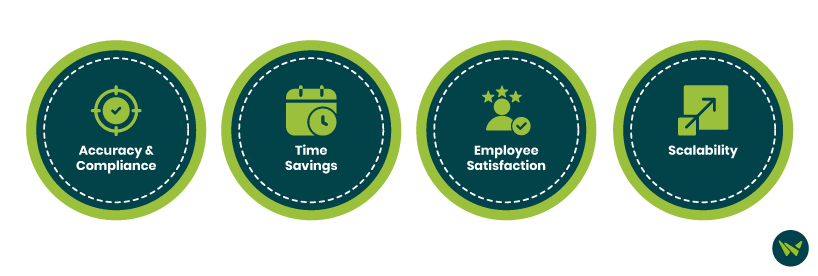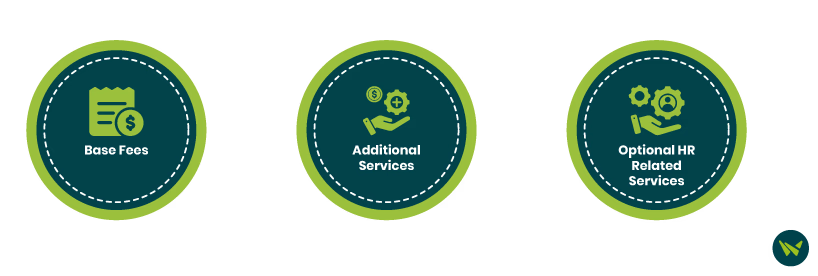Payroll outsourcing has become a crucial choice for organizations seeking to streamline operations, ensure compliance, and focus on their core activities. Companies that outsource payroll can benefit from increased accuracy, lower administrative challenges, and enhanced employee satisfaction. Understanding the expenses involved with payroll outsourcing is critical for making informed decisions.
This article explores how much does it cost to outsource payroll. We will be looking at its various price structures, cost drivers, potential savings, and key factors to consider when selecting the right provider.
Payroll outsourcing means delegating payroll processing and associated tasks to a third-party service provider. These outside vendors are responsible for calculating wages, withholding taxes, distributing paychecks, and ensuring labor and tax compliance.
Benefits Of Payroll Outsourcing

Payroll outsourcing can be valuable for businesses of all sizes, from small to medium and large, especially those without dedicated HR departments or those operating in multiple states or countries. Here are some of the benefits of payroll outsourcing:
- Accuracy And Compliance: Professional payroll services reduce errors and help maintain compliance with ever-changing regulations
- Time Savings: Outsourcing frees up internal resources, allowing employees to focus on strategic initiatives
- Employee Satisfaction: Timely and accurate payroll processing enhances employee trust and morale
- Scalability: Outsourced solutions can easily adapt to business growth and changing needs
On average, outsourced payroll services can cost organizations between $200-$250/employee/year. This estimate includes basic payroll processing and tax filings. The choice of additional services can increase the overall cost. Payroll service providers generally offer three main pricing models:
Per Pay Frequency
Payroll service providers use the per-pay frequency pricing model, which charges a fee every time payroll is processed. This structure generally consists of a flat base price per payroll run plus an additional charge for each employee included in the run.
For example, a company with 10 employees paying bi-weekly:
- Base fee: $35/payroll runs
- Per-employee fee: $3/employee/payroll runs
- Monthly cost: $140 (for bi-weekly payroll runs/month)
Disclaimer: The pricing has been sourced from third-party website and is subject to change.
Per Employee Per Month (PEPM)
The PEPM model features a fixed monthly fee structure in which companies pay a fixed base price plus a set cost for each employee on the payroll. This price approach often allows for unlimited payroll runs each month, offering greater consistency and flexibility for managing payroll cycles.
For example:
- Base fee: $75/month
- Per-employee fee: $6/employee/month
- Monthly cost: $135 for 10 employees
Disclaimer: The pricing has been sourced from third-party website and is subject to change.
Fixed Pricing
Fixed pricing offers a flat monthly charge that covers payroll services for a set number or range of employees, regardless of the number of processed payrolls. This method is especially attractive for organizations with steady employee headcounts and minimum variability in payroll needs.
For example:
- $65 for 1–9 employees
- $125 for 10–20 employees
Disclaimer: The pricing has been sourced from third-party website and is subject to change.

Various factors can impact the overall cost of payroll outsourcing:
Base Fees
- Payroll processing
- Tax calculations and filings
- Direct deposit setup
- Basic reporting
Additional Services
- Multi-state tax filings
- General ledger interface
- Employees pay options (e.g., pay cards, paper checks)
- Courier and delivery charges
- Check stuffing and sealing
- Advanced reporting (e.g., quarterly, year-end, W-2/1099, ACA)
Optional HR-Related Services
- Time and attendance tracking
- Human resource information systems (HRIS)
- Recruitment and applicant tracking
- Benefits enrollment
- Performance management
- Onboarding
Some of the ways companies can save their payroll outsourcing costs are as follows:
Go For An Online DIY Payroll Software
When compared to full-service providers, using online payroll software can save you up to 50% of your payroll expenses per month (PEPM). However, this model requires more hands-on management and a thorough understanding of payroll processes.
Use Bundled Services
Some companies provide bundled packages that combine payroll, HR, and benefits management, mostly at a discounted price. Companies can utilize these bundles and save on their overhead costs.
![]()
Selecting the right payroll outsourcing provider is crucial for maintaining seamless, compliant, and efficient payroll operations. A well-matched partner not only handles basic payroll processes but also mitigates risk and helps you achieve your overall HR objectives. Here are essential elements to help you make your decision:
- Define your needs to ensure the provider offers services aligned with your business requirements
- Consider experience and reputation in your industry and strong client testimonials
- Look for compliance expertise to avoid costly errors and legal issues
- Assess their technology stack for secure, accurate, and integration-friendly payroll software
- Check for customer service based on support availability, responsiveness, and communication
- Compare pricing to find competitive rates without hidden fees
Outsourcing payroll brings valuable advantages, improved accuracy, enhanced compliance, and significant time savings. While costs can vary based on services and providers, understanding pricing models and potential add-ons is essential.
By clearly assessing your business needs and comparing feature offerings, you can choose a payroll outsourcing solution that delivers both operational efficiency and long-term value.
